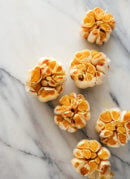Roasted Garlic
- Author:
- Prep Time: 5 minutes
- Cook Time: 45 minutes
- Total Time: 50 minutes
- Yield: 1 head roasted garlic 1x
- Category: Basic
- Method: Roasted
- Cuisine: Mediterranean
Learn how to roast garlic with this easy recipe! This foolproof technique yields the most delicious roasted garlic. Roast as much as you need; each head yields 1 to 1 1/2 tablespoons mashed roasted garlic.

Scale
Ingredients
- 1 or more heads of garlic
- 1 to 2 teaspoons extra-virgin olive oil
Instructions
- Preheat the oven to 400 degrees Fahreneheit. Hold each head of garlic from the base and carefully slice off about 1/4-inch of the top to expose the garlic cloves. We want to be sure each clove is exposed. You may need to peel off some of the outer papery material to see better. If necessary, use a paring knife to cut off the tops of the cloves on the sides. Repeat for additional heads of garlic, if needed.
- Place the garlic bulb(s) in an oven-safe stainless steel saucepan or skillet with an oven-safe lid*, with a base wide enough that the bulbs don’t touch the sides. Drizzle each bulb with 1 to 2 teaspoons of oil, enough to coat the exposed tops. You might need to use your fingers to rub oil that reaches the bottom of the pan back onto the tops.
- Cover your pan and bake for 40 to 70 minutes, checking every 10 minutes after 40 minutes is up (be careful, the pot will be very hot!). The heads are done when they’re nicely golden on top and the cloves are soft enough to easily pierce through with a paring knife. (For greater depth of flavor, roast 5 to 10 minutes longer, but watch out for signs of burning—an acrid smell, or blackened bits).
- Let the roasted garlic cool for at least 10 minutes, or until you can safely handle it. To release the cloves, use a fork (cocktail fork if you have one) or grapefruit spoon or just gently squeeze them from the base (I find this easiest for the inner cloves).
- Use your roasted garlic immediately, or promptly refrigerate for up to 4 days or freeze for up to several months (be sure to label your containers with a use-by date). Do not leave roasted garlic at room temperature, as botulism toxins can grow quickly under these conditions. Learn more about safe garlic storage here.
Notes
*Alternative roasting vessels: I came up with this technique to avoid using aluminum foil. Other options include a baking dish with an oven-safe lid. If you can’t find a suitable lid, try placing a baking sheet placed on top (I think that will work well!).
▸ Nutrition Information
The information shown is an estimate provided by an online nutrition calculator. It should not be considered a substitute for a professional nutritionist’s advice. See our full nutrition disclosure here.
Recipe from Cookie and Kate: https://cookieandkate.com/best-roasted-garlic-recipe/
